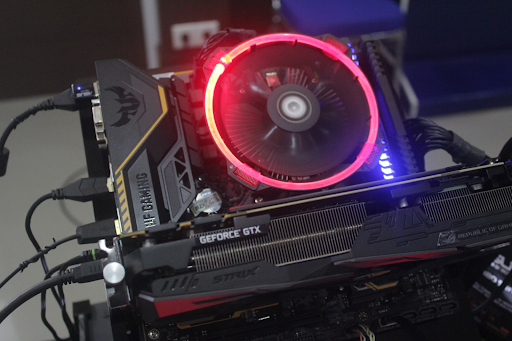From gaming giant to AI darling: Learn how this company became a powerhouse in AI!
|
From the desk of Miles Everson:
Let’s apply this framework in the context of a specific company. Keep reading below to know why this company, once synonymous with gaming, is now one of the world’s most valuable companies. |
||
|
From gaming giant to AI darling: Learn how this company became a powerhouse in AI! Over a decade ago, NVIDIA was worth roughly USD 10 billion. Fast forward to October 2024, the tech giant has a market capitalization of USD 3.4 trillion, making it the world’s second-most valuable company behind Apple. NVIDIA’s rise to the top was propelled mostly by its position as a major player in today’s artificial intelligence (AI) boom. However, this transformation didn’t happen overnight… and to understand how this happened, we need to take a look at NVIDIA’s history. A Leading Figure in the Gaming Industry
NVIDIA was founded in 1993 by Jen-Hsun Huang, Chris Malachowsky, and Curtis Priem. The tech firm began as a company specializing in the design of graphics processing units (GPUs)—a piece of tech designed for rendering videos and images, and is commonly associated with gaming. NVIDIA made a name for itself when it launched the GeForce 256 in 1999 as it became a popular product among consumers who were looking for a dedicated 3D chip that could enable them to play video games. As PC gaming surged in popularity, NVIDIA positioned itself to capture a lion’s share of the market by releasing high performance GPUs across all price points. By the mid-2010s, the tech firm was able to achieve that goal when it released its GeForce 900 series of GPUs, which became immensely popular among gamers and tech reviewers due to its price-to-performance ratio.
Designing GPUs for Non-Graphical Applications Instead of focusing solely on developing tech for PC gaming, NVIDIA diversified the applications of its GPU technology by developing hardware for digital content creation, machine learning, and scientific computing. GPUs were originally designed to accelerate the rendering of 3D graphics. However, the piece of tech was also well-suited for complex computing workloads since it was designed to perform mathematically-intensive calculations. Recognizing the potential of application of GPUs to non-graphical workloads, NVIDIA introduced the Compute Unified Device Architecture (CUDA) in 2006. CUDA is a proprietary parallel computing platform and application programming (API) that enables developers, through the use of specific software, to access the raw computing power of CUDA-enabled GPUs to process data faster than traditional central processing units (CPUs). One of the first applications for CUDA was in oil and gas exploration, as it was utilized in processing massive amounts of data from geological surveys. Today, CUDA is being used in a wide range of industries such as computer graphics, computational finance, data mining, machine learning, and scientific computing. Cryptocurrency Mining and the AI Boom When cryptocurrency mining became popular in the late 2010s, NVIDIA saw higher demands for its GPUs since the latter could perform the complex computations needed to mine cryptocurrencies like Bitcoin and Ethereum. Today, however, AI has become the biggest driver of demand for NVIDIA’s GPUs. Due to the tech firm’s development of CUDA, the latter became instrumental in driving AI research and development forward. In fact, NVIDIA was an early supporter of OpenAI, even going as far as building a special compute module based on its H100 processors to accelerate the training of the large language models (LLMs) the company was developing. The tech giant’s foray into AI didn’t stop at CUDA. It also invested heavily in developing GPUs for use in data centers that are crucial to AI training and inference workloads. NVIDIA hardware is responsible for powering cloud computing solutions such as Amazon Web Services, Microsoft Azure, and Google Cloud. Additionally, NVIDIA expanded its influence into autonomous driving, healthcare, and robotics through its AI-powered solutions. NVIDIA’s Success as Seen Through RDS Professor Joel Litman and Dr. Mark L. Frigo in the book, “Driven” highlighted the importance of fulfilling otherwise unmet customer needs. According to them, the mark of a great and high performing firm lies in its ability to provide offerings that fulfill unmet customer needs. More importantly, these offerings should have no substitute, enabling a company to achieve pricing power, leading to better returns and performance. NVIDIA’s rise as a market leader not only in AI but also in tech can be attributed to its ability to fulfill the unmet needs of its target customers. By recognizing the potential of GPUs beyond gaming and by leveraging the technology for non-graphical applications, the tech giant positioned itself as a major player not only in AI but also in the broader tech market. — If you’re looking to gain a better understanding of Return Driven Strategy and Career Driven Strategy, we highly recommend checking out “Driven” by Professor Litman and Dr. Frigo. Click here to get your copy and learn how this framework can help you in your business strategies and ultimately, in ethically maximizing wealth for your firm. Hope you found this week’s insights interesting and helpful.
Stay tuned for next Tuesday’s Return Driven Strategy! “What is the best reasonable outcome from this particular communication?” Learn more about the importance of holistic communication in next week’s article! |

